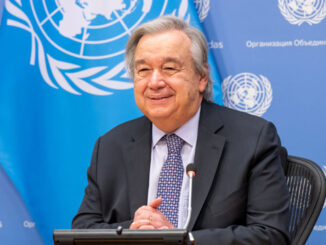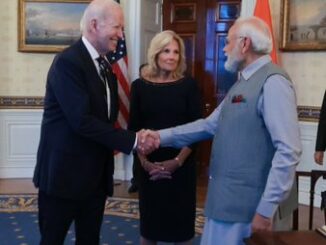
Next week world leaders will gather for the General Assembly’s annual high-level debate, and that despite the Trump administrations’ scorn of multilateralism, “the world can’t afford to abandon the mission of the UN simply because its founding architect has retreated.”

One year ago, against the backdrop of deep geopolitical divides, the United Nations came together to adopt the Pact for the Future and its companion agreements, the Global Digital Compact and the Declaration on Future Generations. These landmark agreements were designed to strengthen the UN’s ability to address conflict prevention, sustainable development, humanitarian assistance, human rights and emerging technologies, such as artificial intelligence.
Eleventh-hour compromises left no country fully satisfied. Yet the adoption of these agreements, despite divisions caused by the wars in Gaza and Ukraine, testified to the enduring promise of the UN and the importance of collective action. It was proof that multilateralism, while badly battered, was not broken.
The road to those agreements was neither smooth nor inevitable. During the yearlong negotiation process, the United States played a critical role in bringing it to a successful outcome. From day one, the Biden administration understood that an effective multilateral system contributed to US security by stabilizing regions, advancing democratic norms, coordinating global crises and opening markets. The UN couldn’t be allowed to fail.
A year later, the political landscape at the UN has shifted dramatically under the Trump administration. The US has pulled back billions of dollars of financial contributions to the UN. The US now routinely denounces the Sustainable Development Goals (SDGs) — the central organizing principle for the UN’s work over the past decade. And USAID, the largest funder of development assistance in the world, has been dismantled, endangering the lives of millions of people and undercutting decades of progress on human rights, democracy promotion and inclusive development.
Looking back, the adoption of the Pact for the Future may be remembered as a fleeting triumph for multilateralism — a moment of collective resolve that briefly cut through geopolitical divides — before more paralysis and discord set in.
Next week, world leaders will gather in New York City for the UN’s high-level week. It should be a time not just for reflection on what’s been lost, but also for resolve about what can still be saved. The world can’t afford to abandon the mission of the UN simply because its founding architect has retreated.
If the UN is to endure, it must rethink how to do its work and who funds it. At least for the next three years, the international community must learn to operate without US funding — and US moral leadership. This effort will require genuine reform and belt-tightening. Beyond across-the-board budget cuts, agencies must be consolidated or eliminated when their functions are duplicative or don’t align with the UN’s core mission.
The UN also must rethink its funding system and broaden the donor base, requiring wealthier emerging economies to shoulder more responsibility. An equitable and effective UN can’t rely on its top two donors for over 40 percent of its funding.
The rest of the world will also need to step up more forcefully to address global issues without waiting for Washington’s blessing. We have already seen encouraging examples in 2025. At the UN Ocean Conference in Nice, France, which the US government did not attend, over 170 countries adopted an action plan with more than 800 commitments, including the creation of one of the world’s largest Marine Protected Areas.
At the fourth Financing for Development conference in Sevilla, Spain, following the withdrawal of the US from the negotiations, more than 190 countries approved major pledges on debt relief, domestic resource mobilization and climate finance.
While no entity can fully make up for the absence of the US government, the UN needs to radically rethink its approach to an often-forgotten party: the private sector. The combined revenues of the world’s top 500 companies rival the budgets of all governments worldwide. If more private-sector involvement could be unlocked, it would drive progress on global challenges. Multinational companies understand that addressing poverty, conflict and climate change isn’t charity; it’s an investment in creating stable, growing markets on which long-term business success depends.
Private sector engagement is about more than funding — it’s also about harnessing expertise that can make UN programs smarter and more effective. By leveraging advanced data tools to sharpen how aid is targeted, world-class logistics to accelerate humanitarian supply chains, fintech to streamline cash assistance and renewable energy to reduce the cost and risk of fueling peacekeeping missions, the UN can deliver results that are more scalable and sustainable.
Nowhere is the case for private sector expertise stronger than in artificial intelligence. Last year, Secretary-General António Guterres noted that AI could help advance nearly 80 percent of the SDGs. A year later, that prediction may well underestimate its potential.
In agriculture, new private sector AI projects are optimizing irrigation and boosting crop yields. In health care, AI is being used to diagnose medical conditions in regions where doctors are scarce. In climate change, AI is helping to model sea-level rise, monitor deforestation and predict floods and wildfires. These aren’t futuristic scenarios. They are operating today, and they show the kind of innovation the UN could scale globally, if there is a commitment to responsible AI development and deployment. The adoption of the first UN resolution on AI in March 2024 — an initiative led by the Biden administration — was a crucial step in that direction.
To be clear, there is no substitute for the resources and moral authority that Washington can bring to global challenges. But the rest of the world can’t wait for a change in the White House before acting. The climate crisis won’t pause. The humanitarian needs of displaced populations won’t diminish. The technological revolution won’t slow down. These challenges demand urgency, and many of the tools for addressing them are still available.
At high-level week, the choice before the global community is stark: allow the Pact for the Future to become a historical footnote or use it as a base for a new kind of multilateralism — one that can withstand even the withdrawal of its most powerful member. The Pact was never meant to be an end in itself. It was always intended as a roadmap for bringing more parties and tools to the table to solve the world’s most serious problems. One year on, that vision is threatened, but not beyond saving.
(Chris Lu was the US ambassador to the United Nations for management and reform (2022-25) and is now the James R. Schlesinger Distinguished Professor at the University of Virginia Miller Center.)
(Source: PassBlue)





Your writing is not only informative but also incredibly inspiring. You have a knack for sparking curiosity and encouraging critical thinking. Thank you for being such a positive influence!